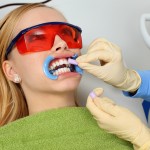
With an increasing focus on aesthetics the popularity of cosmetic tooth whitening has increased. It has been categorised as in-office (professionally ad- ministered), an at-home (professionally dispensed) or an over-the- counter (self-administered) procedure that uses products based on hydrogen peroxide (HP) or carbamide peroxide. While a theoretical advantage of using a light source to improve whitening exists because of its ability to heat HP to increase the decomposition rate in free radicles to oxidise complex organic molecules, this has been questioned.
The aim of this review was to assess whether there are any differences in the bleaching efficacy and TS of bleaching protocols performed with and without light using low and high HP concentrations.
Methods
Searches were conducted in the MEDLINE via PubMed, Cochrane Library, Brazilian Library in Dentistry, and Latin American and Caribbean Health Sciences Literature database [LILACS]) and citation databases Scopus and Web of Science, the System for Information on Grey Literature in Europe, the ProQuest Dissertations and Theses, Periódicos Capes Theses database ,Current Controlled Trials, International Clinical Trials Registry Platform, ClinicalTrials.gov, Rebec, and EU Clinical Trials Register databases.
Parallel and split-mouth randomised controlled trials (RCTs) comparing in-office dental bleaching with and without light in adult patients of any age group were considered. Three reviewers independently selected studies, abstracted data and assessed risk of bias using the Cochrane Tool. The quality of the evidence was rated using the GRADE approach. Random effects meta-analysis was conducted with a subgroup analysis (low and high hydrogen peroxide concentration) for colour change measured by spectrophotometer (ΔE*) or shade guide units (ΔSGU) as well as the risk and intensity of TS.
Results
- 21 RCTs (13 parallel, 9 split-mouth) were included.
- 2 studies were considered to be at high risk of bias
- 16 studies used a shade guide for colour evaluation, 11 a spectrophotometer or colourimeter
- 11 studies evaluated TS.
- Concentration of HP varies from 15-38% and the application protocols were quite varied.
- Different types of light application were used (halogen, LEDs, LED/laser, laser only, Metal-Halide, Plasma-Arc light).
- 17 studies contributed to the meta-analysis
- For colour change in ΔE* both subgroups showed that light use does not increase colour change ; SMD = 0.01 (95%CI; −0.17 to 0.20). (p = .90).
- For colour change in ΔSGU light use did not benefit the colour change in either group SMD = 0.35 [95%CI; −0.13 to 0.84]. (p = .15).
- No significant difference was observed between subgroups of high and low HP concentrations for the risk of tooth sensitivity; RR= 0.94 [95% CI; 0.77 to 1.14], (p = .32).
- There was no difference in the intensity of tooth sensitivity between the groups; SMD = -0.12 [95%CI; −0.76 to 0.53].
Conclusions
The authors concluded: –
Neither the efficacy nor the risk of tooth sensitivity of in-office bleaching was influenced by the use of light, regardless of the hydrogen peroxide concentration. However, this should be interpreted with caution, as it represents an overall comparison without considering variations in the protocols (number of bleaching sessions, product, and kind of the light) of the bleaching techniques in the studies included
Comments
This review adopted a sound methodological approach and employed an extensive database search identifying 21 RCTs in total. Looking at the risk of bias assessment (RoB) table only 5 studies were at low risk of bias and the authors highlight the fact that randomisation was poorly executed or reported. The authors report that only 2 RCTs were at high risk of bias although the RoB table identifies 5 studies with at least one criteria at high risk.
While the authors have essentially undertaken 4 main comparison bleaching v bleaching using light, and high v low concentration HP there authors not considerable variation in the bleaching and activation protocols and the types of light source used. However, the overall number of studies is relatively small and the number of individual comparisons of different combination is likely to be smaller still. It is worth noting that this group of authors are developing a network meta-analysis which may address some of these issues.We covered an earlier review by He et al ( Dental Elf – 2nd May 2012) that included a smaller number of studies which also suggested that use of a light source did not improve the bleaching effect but increase tooth sensitivity while this review suggests no difference.
Links
Primary Paper
Maran BM, Burey A, de Paris Matos T, Loguercio AD, Reis A. In-office dental bleaching with light vs. without light: A systematic review and meta-analysis. J Dent. 2018 Mar;70:1-13. doi: 10.1016/j.jdent.2017.11.007. Epub 2017 Dec 29. Review. PubMed PMID: 29289725.
Original review protocol on PROSPERO
Other references
Dental Elf – 2nd May 2012
Dental Elf – Tooth Whitening Blogs

[…] post Tooth whitening: Does light activation improve efficacy? appeared first on National Elf […]
[…] Tooth whitening: Does light activation improve efficacy? […]